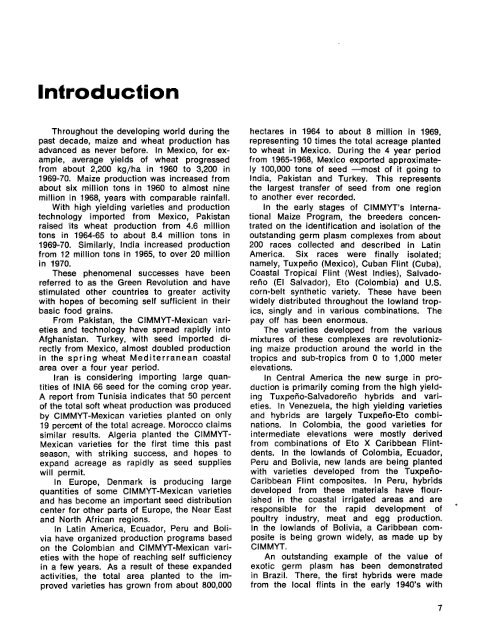REPORT - Search CIMMYT repository
REPORT - Search CIMMYT repository
REPORT - Search CIMMYT repository
Create successful ePaper yourself
Turn your PDF publications into a flip-book with our unique Google optimized e-Paper software.
Introduction<br />
Throughout the developing world during the<br />
past decade, maize and wheat production has<br />
advanced as never before. In Mexico, for example,<br />
average yields of wheat progressed<br />
from about 2,200 kg/ha in 1960 to 3,200 in<br />
1969-70. Maize production was increased from<br />
about six million tons in 1960 to almost nine<br />
million in 1968, years with comparable rainfall.<br />
With high yielding varieties and production<br />
technology imported from Mexico, Pakistan<br />
raised its wheat production from 4.6 million<br />
tons in 1964-65 to about 8.4 million tons in<br />
1969-70. Similarly, India increased production<br />
from 12 million tons in 1965, to over 20 million<br />
in 1970.<br />
These phenomenal successes have been<br />
referred to as the Green Revolution and have<br />
stimulated other countries to greater activity<br />
with hopes of becoming self sufficient in their<br />
basic food grains.<br />
From Pakistan, the <strong>CIMMYT</strong>-Mexican varieties<br />
and technology have spread rapidly into<br />
Afghanistan. Turkey, with seed imported directly<br />
from Mexico, almost doubled production<br />
in the spring wheat Mediterranean coastal<br />
area over a four year period.<br />
Iran is considering importing large quantities<br />
of INIA 66 seed for the coming crop year.<br />
A report from Tunisia indicates that 50 percent<br />
of the total soft wheat production was produced<br />
by <strong>CIMMYT</strong>-Mexican varieties planted on only<br />
19 percent of the total acreage. Morocco claims<br />
similar results. Algeria planted the <strong>CIMMYT</strong><br />
Mexican varieties for the first time this past<br />
season, with striking success, and hopes to<br />
expand acreage as rapidly as seed supplies<br />
will permit.<br />
In Europe, Denmark is producing large<br />
quantities of some <strong>CIMMYT</strong>-Mexican varieties<br />
and has become an important seed distribution<br />
center for other parts of Europe, the Near East<br />
and North African regions.<br />
In Latin America, Ecuador, Peru and Bolivia<br />
have organized production programs based<br />
on the Colombian and <strong>CIMMYT</strong>-Mexican varieties<br />
with the hope of reaching self sufficiency<br />
in a few years. As a result of these expanded<br />
activities, the total area planted to the improved<br />
varieties has grown from about 800,000<br />
hectares in 1964 to about 8 million in 1969,<br />
representing 10 times the total acreage planted<br />
to wheat in Mexico. During the 4 year period<br />
from 1965-1968, Mexico exported approximately<br />
100,000 tons of seed -most of it going to<br />
India, Pakistan and Turkey. This represents<br />
the largest transfer of seed from one region<br />
to another ever recorded.<br />
In the early stages of <strong>CIMMYT</strong>'s International<br />
Maize Program, the breeders concentrated<br />
on the identification and isolation of the<br />
outstanding germ plasm complexes from about<br />
200 races collected and described in Latin<br />
America. Six races were finally isolated;<br />
namely, Tuxpeiio (Mexico), Cuban Flint (Cuba),<br />
Coastal Tropical Flint (West Indies), Salvadoreiio<br />
(EI Salvador), Eto (Colombia) and U.S.<br />
corn-belt synthetic variety. These have been<br />
widely distributed throughout the lowland tropics,<br />
singly and in various combinations. The<br />
payoff has been enormous.<br />
The varieties developed from the various<br />
mixtures of these complexes are revolutionizing<br />
maize production around the world in the<br />
tropics and sUb-tropics from 0 to 1,000 meter<br />
elevations.<br />
In Central America the new surge in production<br />
is primarily coming from the high yielding<br />
Tuxpeiio-Salvadoreiio hybrids and varieties.<br />
In Venezuela, the high yielding varieties<br />
and hybrids are largely Tuxpeiio-Eto combinations.<br />
In Colombia, the good varieties for<br />
intermediate elevations were mostly derived<br />
from combinations of Eto X Caribbean Flintdents.<br />
In the lowlands of Colombia, Ecuador,<br />
Peru and Bolivia, new lands are being planted<br />
with varieties developed from the Tuxpeiio<br />
Caribbean Flint composites. In Peru, hybrids<br />
developed from these materials have flourished<br />
in the coastal irrigated areas and are<br />
responsible for the rapid development of<br />
poultry industry, meat and egg production.<br />
In the lowlands of Bolivia, a Caribbean composite<br />
is being grown widely, as made up by<br />
<strong>CIMMYT</strong>.<br />
An outstanding example of the value of<br />
exotic germ plasm has been demonstrated<br />
in Brazil. There, the first hybrids were made<br />
from the local flints in the early 1940's with<br />
7

















